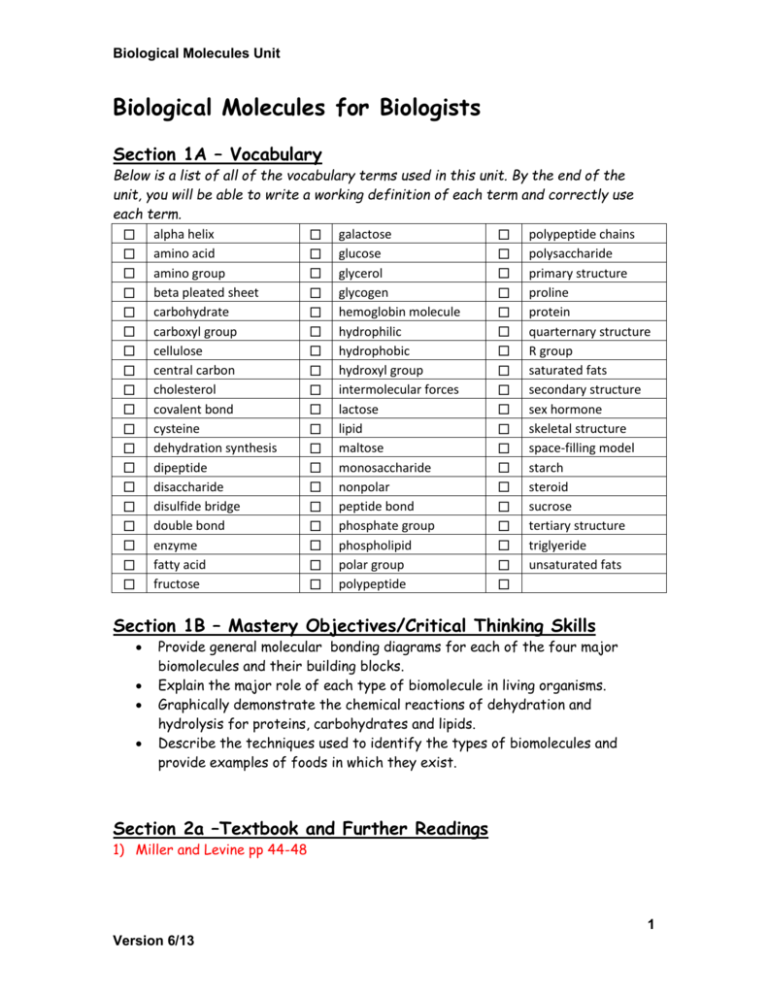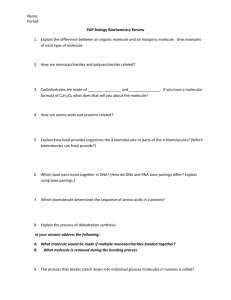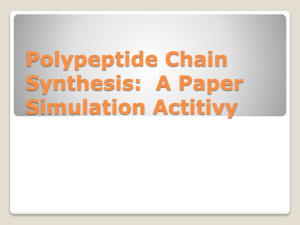Ecology Unit Outline - nnhsbiology
advertisement

Biological Molecules Unit Biological Molecules for Biologists Section 1A – Vocabulary Below is a list of all of the vocabulary terms used in this unit. By the end of the unit, you will be able to write a working definition of each term and correctly use each term. alpha helix galactose polypeptide chains amino acid glucose polysaccharide amino group glycerol primary structure beta pleated sheet glycogen proline carbohydrate hemoglobin molecule protein carboxyl group hydrophilic quarternary structure cellulose hydrophobic R group central carbon hydroxyl group saturated fats cholesterol intermolecular forces secondary structure covalent bond lactose sex hormone cysteine lipid skeletal structure dehydration synthesis maltose space-filling model dipeptide monosaccharide starch disaccharide nonpolar steroid disulfide bridge peptide bond sucrose double bond phosphate group tertiary structure enzyme phospholipid triglyeride fatty acid polar group unsaturated fats fructose polypeptide Section 1B – Mastery Objectives/Critical Thinking Skills Provide general molecular bonding diagrams for each of the four major biomolecules and their building blocks. Explain the major role of each type of biomolecule in living organisms. Graphically demonstrate the chemical reactions of dehydration and hydrolysis for proteins, carbohydrates and lipids. Describe the techniques used to identify the types of biomolecules and provide examples of foods in which they exist. Section 2a –Textbook and Further Readings 1) Miller and Levine pp 44-48 1 Version 6/13 Biological Molecules Unit Section 2b – Relevant Websites http://www.biologymad.com/ - WOW!!! This site has it all – need an answer – just look here. This is a UK site designed for high schoolers studying for their entrance exams to college. Well written and illustrated. Better than our textbook and more complete! http://www.biology.arizona.edu/biochemistry/biochemistry.html - The Biology Projects Chemistry of Life problem sets and tutorials and And of course the class wiki http://nnhsbiology.pbworks.com Section 3 – In class activities Lecture on various biomolecules Model building of each type of biomolecule Food Lab Food Project Section 4 –– Outside Class Assignments Thoughtfully answer each of the following questions or tasks. Include all your reasoning and work wherever it seems appropriate. Type the question and then the answer. Go in order. Due dates for each assignment will be given in class. (Please remember - homework that is passed in late is automatically discounted 15% and 0% after the unit test.) 1) Create a hierarchical concept map for each of the following sets of terms: a) fatty acid, glycerol, lipid, unsaturated fat, phospholipid, saturated fat, steroid, triglyeride. Dehydration synthesis. b) Carbohydrate, cellulose, disaccharide, fructose, galactose, glucose, lactose, maltose, monosaccharide, polysaccharide, simple sugar, starch, sucrose c) amino group, carboxyl group, covalent bond, central carbon. hydrophilic, hydrophobic, hydroxyl group, nonpolar, polar d) dehydration synthesis, amino acid, monosaccharide, glycerol, fatty acid, water molecule, dipeptide, polysaccharide, triglyceride e) alpha helix, beta pleated sheet, disulfide bridge, enzyme, hemoglobin molecule, polypeptide, polypeptide chains, primary structure, proline, protein, quarternary structure, R group, secondary structure, tertiary structure 2) Read and follow the directions as you color in the following pages attached to this packet a) Lipids b) Carbohydrates 2 Version 6/13 Biological Molecules Unit c) d) e) f) g) Simple Sugars Amino acids Introduction to Proteins Protein Structure 1 Protein Structure 2 3) Make a table with four columns. In the first column, list each type of biomolecule (protein, carbohydrate, lipid, nucleic acid). In column two list the elements that combine to make the biomolecule. In column three list the building blocks (monomers) of the biomolecule. In column four list the roles these biomolecules have in living organisms. 4) Lipids and sugars are closely related in living things. a. List three similarities these two biomolecules share b. List six differences (3 for each) between these two biomolecules. 5) Proteins, lipids and carbohydrates are formed by a chemical reaction called dehydration synthesis. a. Why is the chemical reaction that occurs when these biomolecules are formed called dehydration synthesis b. Write the equation for dehydration synthesis for the formation of sucrose c. Using molecular skeletal models, diagram disaccharide formation d. Write the chemical equation for the formation of a dipeptide e. Using molecular skeletal models, diagram dipeptide formation f. Write the chemical equation for the formation of a lipid (triglyceride) g. Using molecular skeletal models, diagram triglyceride formation 6) EDTA is an ingredient in salad dressing that keeps the oil and vinegar from separating into different layers in the bottle. EDTA is soap. Explain how the EDTA works to keep these two liquids mixed. 7) There are 20 essential amino acids that are used to build all of the proteins in your body. a. Draw the general structure for an amino acid b. Draw at least 5 different amino acids and state whether they are polar or nonpolar (Hint: check out the websites listed) c. If an amino acid is polar, would it tend to face outward towards water or inward toward the center of the protein? Explain your reasoning. d. Select two of your amino acids and show how they join together to form a dipeptide. e. Which amino acids are most likely to form sulfide bridges with other amino acids? 3 Version 6/13 Biological Molecules Unit f. Why are these intermolecular forces important in determining protein shape? 8) Proteins work because they have specific shapes that let them do their job. a. List the four levels of organization of protein structure. b. Describe which chemical forces (, hydrophilic, hydrophobic, hydrogen bonding, disulfide bridges, etc, ) are associated with each level of protein organization and how those forces work to control that level of organization of a protein. c. What makes proline so special and how does it influence protein shape? 4 Version 6/13









